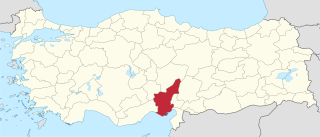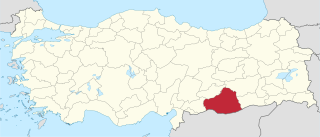
Ethiopian cuisine characteristically consists of vegetable and often very spicy meat dishes. This is usually in the form of wat, a thick stew, served atop injera, a large sourdough flatbread, which is about 50 centimeters in diameter and made out of fermented teff flour. Ethiopians eat most of the time with their right hands, using pieces of injera to pick up bites of entrées and side dishes..
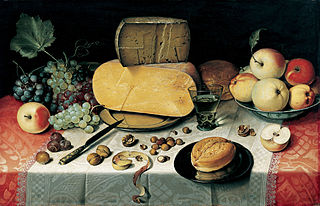
Breakfast is the first meal of a day. The word in English refers to breaking the fasting period of the prior night. There is a strong tendency for one or more "typical", or "traditional", breakfast menus to exist in most places, but the composition of this varies widely from place to place, and has varied over time, so that globally a very wide range of preparations and ingredients are now associated with breakfast.

Turkish coffee is coffee prepared using very finely ground coffee beans, unfiltered. The same method is used in many Middle Eastern and Southeastern European countries.

Ais kacang, literally meaning "bean ice", also commonly known as ABC, is a Malaysian dessert which is also common in Singapore and Brunei.

Tea culture is defined by the way tea is made and consumed, by the way the people interact with tea, and by the aesthetics surrounding tea drinking. It includes aspects of tea production, tea brewing, tea arts and ceremony, society, history, health, ethics, education, and communication and media issues.

Arab cuisine is the cuisine of the Arabs, defined as the various regional cuisines spanning the Arab world, from the Maghreb to the Fertile Crescent and the Arabian Peninsula. The cuisines are often centuries old and reflect the culture of great trading in spices, herbs, and foods. The three main regions, also known as the Maghreb, the Fertile Crescent, and the Arabian Peninsula have many similarities, but also many unique traditions. These kitchens have been influenced by the climate, cultivating possibilities, as well as trading possibilities. The kitchens of the Maghreb and Levant are relatively young kitchens that were developed over the past centuries. The kitchen from the Khaleej region is a very old kitchen. The kitchens can be divided into urban and rural kitchens.

Ipoh white coffee is a popular coffee drink which originated in Ipoh, Perak, Malaysia, resulting in Ipoh being named one of the top three coffee towns by Lonely Planet. The coffee beans are roasted with palm oil margarine, and the resulting coffee is served with condensed milk.

A cezve is a small long-handled pot with a pouring lip designed specifically to make Turkish coffee. It is traditionally made of brass or copper, occasionally also silver or gold. In more recent times cezveler are also made from stainless steel, aluminium, or ceramics.
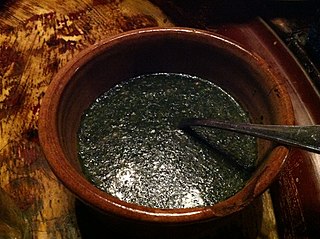
Mulukhiyah or mulukhiyyah is the leaves of Corchorus olitorius, commonly known as the Arab's mallow, Nalta jute, or tossa jute. It is used as a vegetable. It is popular in Middle East, East African and North African countries. Mulukhiyah is rather bitter, and when boiled, the resulting liquid is a thick, highly mucilaginous broth; it is often described as "slimy", rather like cooked okra. Mulukhiyah is generally eaten cooked, not raw, and is most frequently turned into a kind of soup or stew, typically bearing the same name as the vegetable in the local language. Traditionally mulukhiyah is cooked with chicken or at least chicken stock for flavor and is served with white rice, accompanied with lemon or lime.

Mie rebus/Mi rebus or mee rebus, literally "boiled noodles", is a noodle soup dish from Southeast Asia, popular in Indonesia, Malaysia, and Singapore. It is also often called mie kuah.

Arabic coffee refers to a version of the brewed coffee of Coffea arabica beans. Arabic coffee is typically grown at a height of 1000 to 2000 meters, and represents about 60-70% of the coffee industry in the world. Most Arab countries throughout the Middle East have developed unique methods for brewing and preparing coffee. Cardamom is an often-added spice, but it can alternatively be served plain.
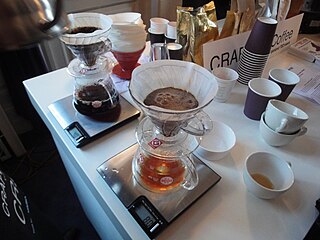
Coffee preparation is the process of turning coffee beans into a beverage. While the particular steps vary with the type of coffee and with the raw materials, the process includes four basic steps: raw coffee beans must be roasted, the roasted coffee beans must then be ground, the ground coffee must then be mixed with hot water for a certain time (brewed), and finally the liquid coffee must be separated from the used grounds.

The culture of Eritrea is the collective cultural heritage of the various populations native to Eritrea. It shares historic commonalities with the traditions of Ethiopia, Somalia, Djibouti and Sudan. The local culture consists of various, and often quite similar, traditions practiced by the nation's many Cushitic and Ethiopian Semitic-speaking Afro-Asiatic ethnic groups, in addition to those practiced by the area's Nilotic minorities. Eritrean culture is in some ways similar to the cultures of other Horners.

Saudi Arabian cuisine encompasses the cuisines and foods of Saudi Arabia. In spite of the existence of many common dishes, Saudi dishes vary from a region to another as the culture itself varies.

Jordanian cuisine is a traditional style of food preparation originating from, or commonly used in Jordan that has developed from centuries of social and political change.

A dallah is a traditional Arabic coffee pot used for centuries to brew and serve Qahwa (gahwa), an Arabic coffee or Gulf coffee made through a multi-step ritual, and Khaleeji, a spicy, bitter coffee traditionally served during feasts like Eid al-Fitr.

Masala chai is a flavoured tea beverage made by brewing black tea with a mixture of aromatic spices and herbs. Originating in the Indian subcontinent, the beverage has gained worldwide popularity, becoming a feature in many coffee and tea houses. Although traditionally prepared as a decoction of green cardamom pods, cinnamon sticks, ground cloves, ground ginger, and black peppercorn together with black tea leaves, retail versions include tea bags for infusion, instant powdered mixtures, and concentrates.

Middle Eastern cuisine is the cuisine of the various countries and peoples of the Middle East. The cuisine of the region is diverse while having a degree of homogeneity. It includes Arab, Iranian/Persian, Israeli/Jewish, Assyrian, Kurdish, Cypriot, and Turkish cuisines. In 2017, Middle Eastern cuisine was claimed by many sources to be one of the most popular and fastest growing ethnic cuisines in the US. Some commonly used ingredients include olives and olive oil, pitas, honey, sesame seeds, dates, sumac, chickpeas, mint, rice, and parsley. Some popular dishes include kebabs, dolma, falafel, baklava, yogurt, doner kebab, shawarma and Mulukhiyah.

